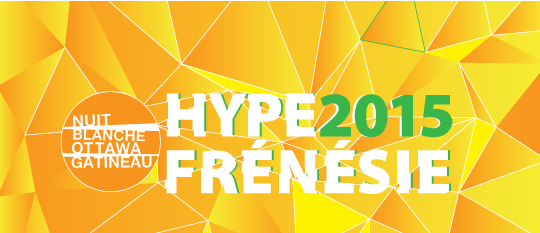
By: Lydia Miliokas
This year’s festival theme calls on artists to creatively refigure the HYPE space. The very mention of the word hype stirs up a myriad of connotations and contradictions, from positive to negative notions of individual and collective anticipation, frenzy, exaggeration, illusion and, perhaps inevitably, disillusionment. As the festival’s creative team suggest in their curatorial statement, we only have to consider the theory of Gartner Inc.’s “hype cycle” to know that hype simultaneously functions as both a state and a process: a highly abstract concept made physically tangible through the outcomes of its performance. Nuit Blanche Ottawa + Gatineau 2015 challenges cultural producers to embrace the night and follow this hype to new sites of experimentation, where artists might freely exchange, evolve, edit and alter ideas to reveal innovative and exciting new potentials in their work.
For the artists, HYPE captures the energy of this one-night event and enables them to play within a more open network. Thematically, hype also speaks to the significance of the audience in the production of meaning-making. To understand hype is inherently a sensory experience, one that grows and multiplies in the liminal spaces of the temporary urban art festival. In his essay “The Tourist Affect: Escape and Syncresis on the Las Vegas Strip,” Dr. Rob Shields describes the immaterial quality of such affects as fluid and mobile, explaining that it “accomplishes a socialization of time and space at the same time as the social is spatialized. Affect brings space into the realm of the social in the sense of microgeography of territories and assembled interfacing bodies and objects” (Shields 121). In this way, hype is ever present, in a very material sense, as it informs the artwork displayed and, in a virtual sense, as the psychological threshold for audiences that anxiously wait for the night to begin.
HYPE is experienced by creators and viewers. Although it is true that this experience can be deeply personal and individual, the function of hype as a verb is one that implies sensationalism, publicity, and exposure. The feeling of hype rises and falls, waxing and waning as larger and larger crowds assemble and dissipate to engage with the work and each other in reimagined spaces. It is for this reason that HYPE implies the very social act central to festivals, in which people from all kinds of groups, neighbourhoods, and communities might come together to share not only in the experience, but to enhance its meaning and the meaning of the spaces that surround and contain it.
Works Cited:
Shields, Robert. “The Tourist Affect: Escape and Syncresis on the Las Vegas Strip.” Ecologies of Affect: Placing Nostalgia, Desire, and Hope. Ed. Tonya K. Davidson, Ondine Park, and Rob Shields. Waterloo: Wilfrid Laurier Press, 2011. 105 – 126. Print.
Lydia Miliokas is a MA Interdisciplinary Studies student, within the Faculty of Fine Arts at the University of Regina.